Sweet corn - growing: from planting to leaving
"Hot Sweet Corn!" Who has not heard these words in the summer, on the beach, from the annoying sellers of a seasonal product. What kind of corn is it and how does it differ from other types?
Content:
- Sweet corn: description and useful properties
- Popular varieties of cereals
- Growing sweet corn
- Diseases and pests of corn
Sweet corn: description and useful properties
Corn came to Europe from America, its southern and central regions. Fodder came to us in the 17th century, and sugar - a couple of centuries later. But sweet corn became widespread several decades ago. It is usually eaten boiled when the seeds are just forming and growing, but not yet hard. This condition is called milky-wax ripeness. It can be frozen or canned and used in salads during the winter.
Beneficial features:
- Sweet corn fruits contain a large amount of proteins, starch and dextrin, fats, sugar, and mineral salts.
- This plant is valued for the content of a large amount of vitamins of groups of main groups, amino acids (lysine, tryptophan).
- Corn oil is made from corn seeds, corn silk extract, which, moreover, are medicinal products.
Features of the structure:
- Sugar maize (maize) is an annual plant reaching a height of 2.5 m.
- Its fibrous roots penetrate deep into the ground up to one and a half meters.
- The leaves are long (up to a meter), wide (up to 10 cm), linear-lanceolate, dark green.
- The stem can be up to 7 cm thick.
- Corn has two types of flowers: male, located on the apical panicles, and female, collected on the cob, growing from the axils of the leaves.
One or two ears are formed on one plant. If more of them are tied, then they will not have time to ripen. The length of each ear depends on the variety and growing conditions. Length varies from 4 to 50 cm, width - from 2 to 10 cm. The mass of a ripe ear is from 30 to 500 g. It is densely surrounded by leaf wrappers. A bunch of pistils emerge from them. The pollen from male flowers is shaken off by the wind and falls on the pistils. Caryopses are formed, which tightly fit the ear. The caryopses are yellow, reddish, white and even black in color.
There are very beautiful varieties, the kernels of one cob are painted simultaneously in yellow, pink, blue, purple colors and their shades.
It is believed that corn is the oldest cereal plant in the world. Corn differs from other cereals in that it is not hollow inside. There are 9 botanical groups of corn, one of which is sugar corn.
Popular varieties of cereals
Varieties for warm regions:
- Kuban canning-148
- Zarya-123
- Fragrant
- Early golden
- Sugar-590
- Accord-72 (hybrid)
Varieties for the middle lane and the Urals:
- Pioneer of the North
- Tiraspolskaya-33
- White Night
- Triple sweetness
Growing sweet corn
Sweet corn, like other species, is a heat-loving plant. Its seeds germinate at a temperature of 8-13 degrees. A sinking during germination often results in seedlings not appearing on the surface. The optimum temperature is 20-24 degrees. Grows poorly in the shade.
The best precursors for sweet corn are beans, tomato, cabbage, melons, root crops. The plot begins to be prepared immediately after harvesting the predecessor:
- Add 3 kg of humus, 30 g of superphosphate and 10 g of potassium salt per 1 m2.
- If the soil is acidic, it is advisable to carry out liming before planting, adding 500 g of lime per square meter of area.
- They plow the land to a depth of 30 cm.
Seed preparation and planting:
- The seeds are taken large, from the middle part of the cob. Warm up for a week at a temperature of 35 degrees. You can germinate seeds, but only if they are sown in warm and moist soil.
- Seeds are sown to a depth of 5-8 cm.The distance between plants in rows is 35 cm, between rows is 70 cm.
- If the soil is dry and the area allocated for corn is small, it is a good idea to water each hole, wait for the water to absorb, drop the seeds and cover them with damp earth.
- Sprinkle dry on top to better retain moisture.
In places of risky farming (middle lane), it is better to sow seeds in varying degrees of readiness: dry, swollen, sprouted. If the sprouted ones are sunk and do not sprout, then the dry ones will germinate later. Of course, sowing seeds from three jars into one hole is not very easy. And if they all germinate, then the weak will need to be removed along with the roots.
To feast on young corn for as long as possible, the seeds are sown in several stages with a difference of two weeks.
In the northern regions, where corn may not reach the state of milky-wax ripeness, it is grown seedlings... Seeds are sown from mid-May in peat pots. Seedlings are hardened by taking them outside for a while. Planted in the garden 20 days after germination. After planting, watered using about 1 liter of water.
After the emergence of most shoots (10-12 days), the aisles are loosened to a depth of 7 cm, removing weeds... When they have 4 leaves, one sprout, the strongest, is left in the hole.
Care Tips:
- In the 6-leaf phase of the plant fertilize, introducing 100 g of superphosphate, 50 g of potassium salt and ammonium nitrate per 10 square meters of area. It is better to mix these fertilizers, dissolve in water and pour the resulting mixture along the grooves made along the rows at a distance of 20 cm from the plants.
- When plants reach a height of 50-70 cm, their spud... This stimulates the formation of adventitious roots. They help the plant to get more nutrients and moisture from the soil. They increase the plant's resistance to wind gusts that can turn it out of the ground.
- Watered 4 times per season. After each watering, the soil is loosened.
- During the season, corn is loosened several times. This is usually done after rain. After it reaches a meter in height, it will not be easy to do this.
- Permanently remove stepchildren that reduce yields corn and delay the maturation of the main ears.
- When the corn is in bloom, you can help pollinate it. To do this, at noon, the plants are shaken so that the pollen flies more actively from the apical panicles.
To get ripe seeds for planting next year, take the cobs that ripen the earliest. If they do not have time to ripen before the onset of frost, experts advise to uproot the plant and hide it in a shed. The wrapping leaves are removed in the spring. It is better to store seeds on the cob. They are hung, tied with extreme wrapping sheets. So they are better stored and remain germinating longer.
Harvest by examining each ear. Ready-to-eat pluck. They should be at the stage of milky-wax ripeness, sufficiently formed, but soft. You need to consume them as quickly as possible. Indeed, in just one day, the amount of sugar in grains will decrease by a quarter. The crop is harvested every other day.
Diseases and pests of corn
Sweet corn is quite resistant to pests and diseases. But still, some stems can not only be affected by them, but also die from their impact. Sometimes the stem, leaves look healthy, and the ears are not set.Therefore, when doing weeding or other maintenance operations for sweet corn, carefully inspect the parts of the plant.
Major diseases corn:
- Dust smut is a fungal disease in which the panicle becomes covered with black spores, which fly around at the slightest movement. The ears of the affected plant are completely unusable. They are removed, the soil is dug deeply. For prevention, the soil is treated with Ditox, Granivit.
- Fusarium blight appears as a pink bloom on germinating seeds or ears (Fusarium on the cob). The disease can go unnoticed, but the quality of the seeds drops sharply. They become soft and not recyclable. They grow resistant seeds treated with Granivit, Vitavax 200.
- Bubble smut affects the entire plant. It becomes covered with gray swollen spots up to 15 cm in size. For prevention disinfect the soil, use crop rotation, treated with Ditox, Vitavax.
More information can be found in the video:
The main pests of sweet corn, like other species, are:
- The defeat of corn by a stem moth is evidenced by caterpillars, which settle in the leaf funnel and begin to multiply actively there. In the process of growth, the caterpillars of the stem moths cause significant damage to the plant. You need to fight by treating the area with insecticides twice (Decis and others). First, this is done as soon as the caterpillars have appeared, the second - when there are a lot of them. Seeds are disinfected with Gaucho.
- Root aphids attack the plant in hot weather. Plants become weak, grow slowly, are affected by fungal diseases, and may even die. You need to fight by spraying with insecticides, often changing drugs. After all, aphids quickly get used to them and stop responding.
- Cotton scoops damage pistil filaments. Large rounded holes appear in the upper leaves, and remnants of caterpillar vital activity appear inside the cob. They are treated with Decis.
- Swedish flies begin to damage seedlings shortly after they emerge. Holes appear on the leaves and stems, the plants get sick. They are treated with Karate, Sumi-alpha, Decis preparations.
- Wireworms attack maize that grows on recently plowed hayfields or virgin lands. They gnaw through the seeds before the seedlings emerge on the surface. To avoid damage, seeds are treated with Gaucho, Cosmos preparations.



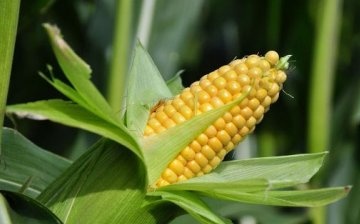
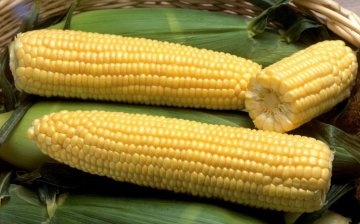
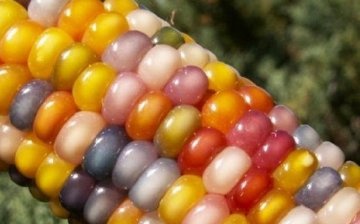

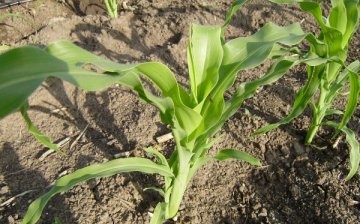
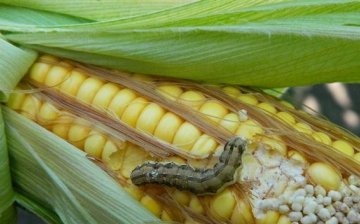






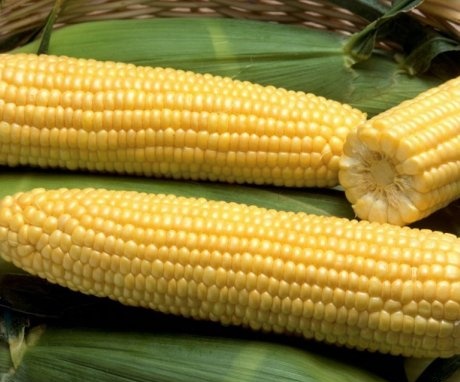
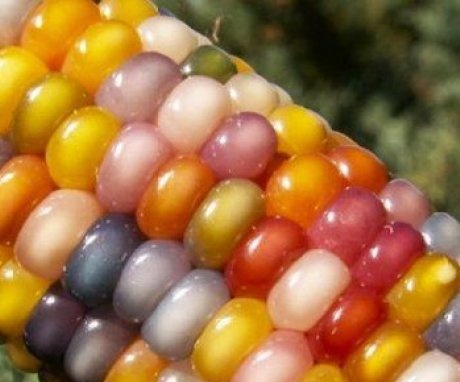

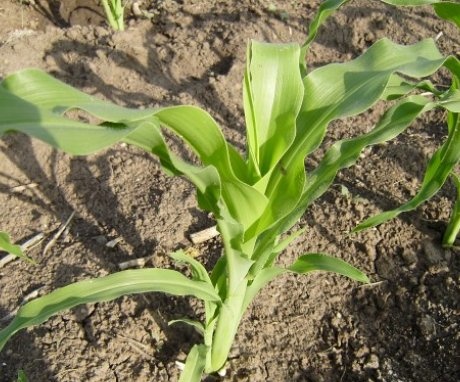
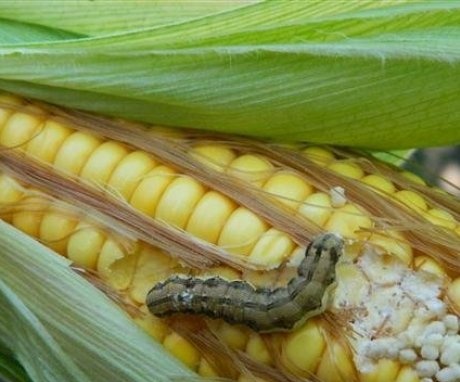
To be honest, I don’t really understand how it is possible to grow corn in our region, and not only sugar corn. I regularly sow it in the country, the seeds give a powerful stem, but the ear develops a small one, and the birds are zealous.